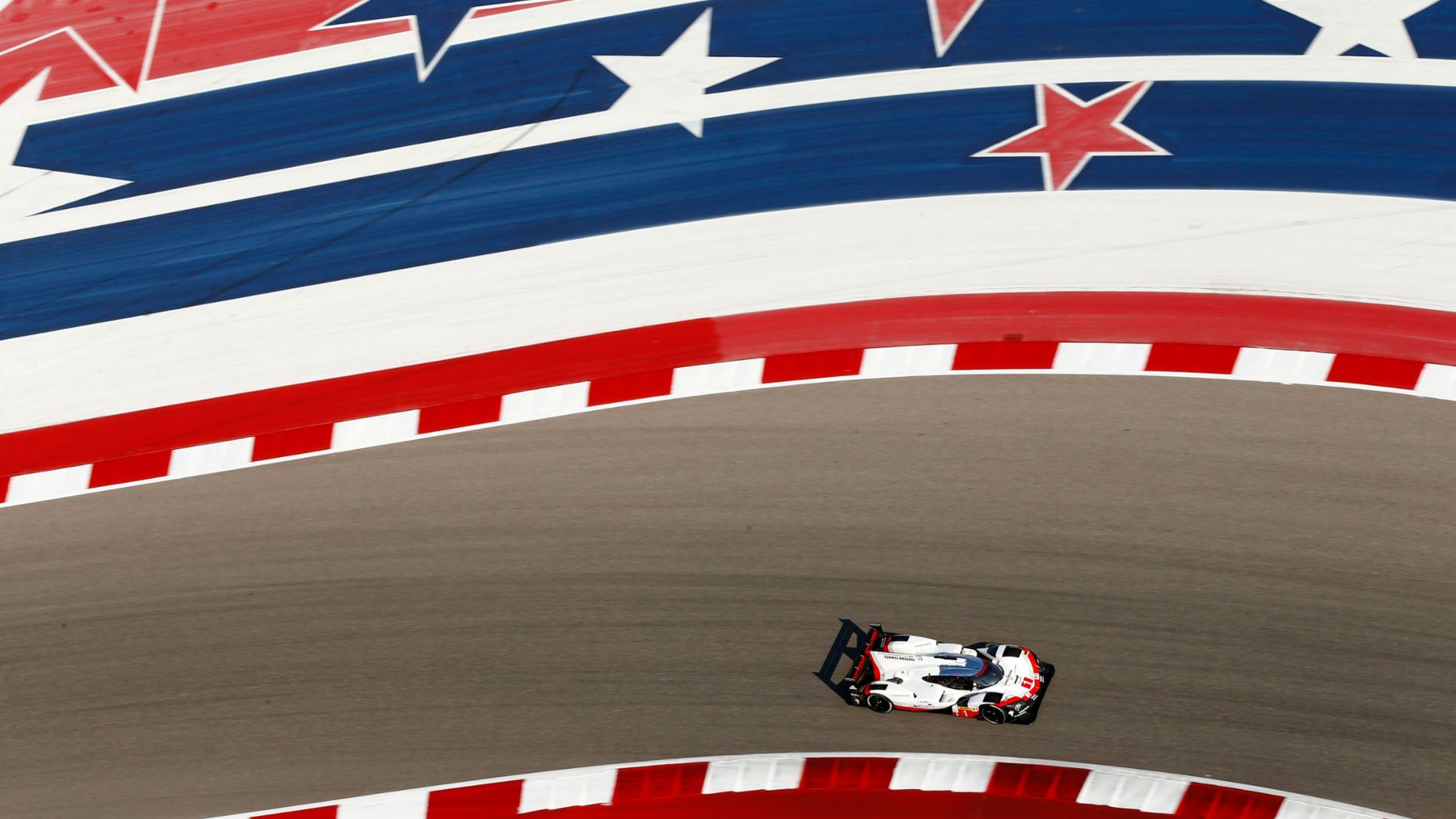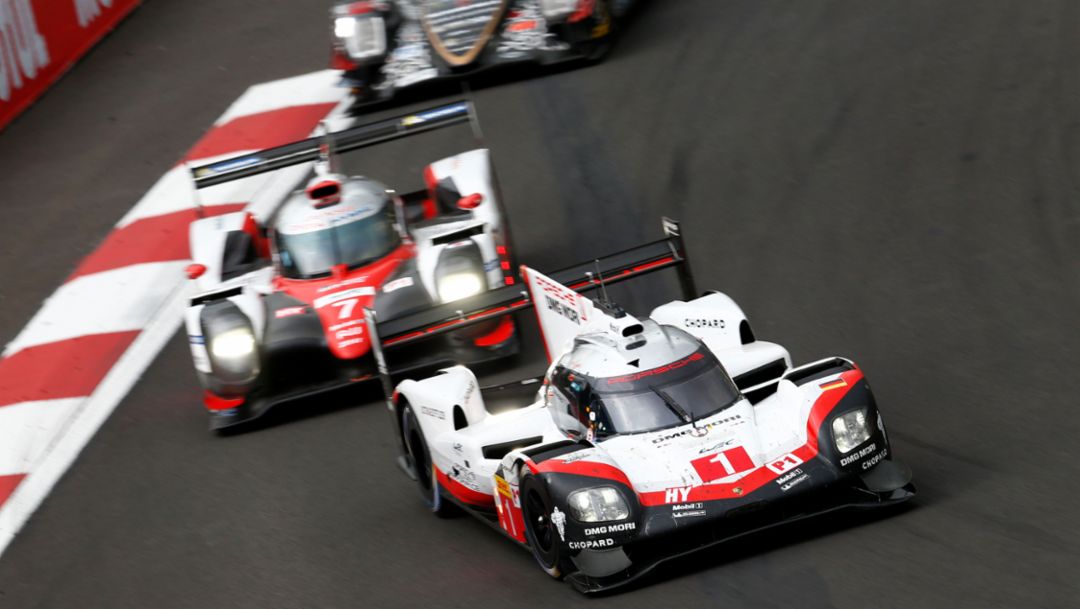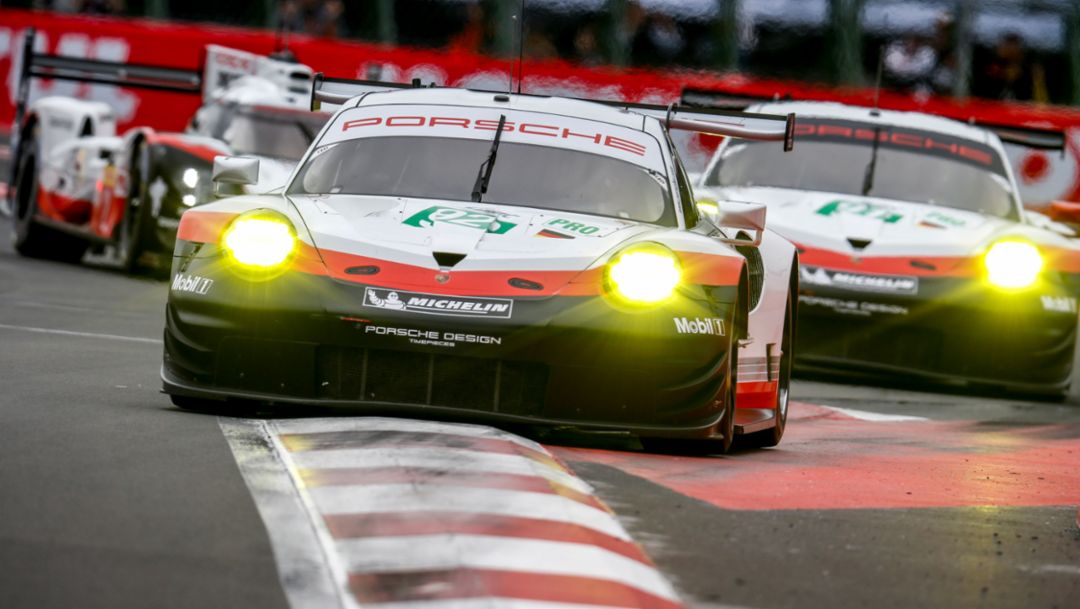LMP1 practice
The Circuit of the Americas (COTA), the 5.513 kilometre long Formula One circuit is a challenging track. Additionally, the current ambient temperature of 34 degrees Celsius is expected to be the same for the six-hour race. Porsche hopes to make another step towards their aim of title defence.
Current world champion Neel Jani (CH), who shares a Porsche 919 Hybrid with André Lotterer (DE) and Nick Tandy (GB), set the best lap time of the day in 1:45.860 minutes at the beginning of the second session on Thrusday. Earl Bamber (NZ) was second fastest in the sister car, doing a lap in 1:46.401 minutes. Bamber and his partners Timo Bernhard (DE) and Brendon Hartley (NZ) are the current world championship leaders. In the first of the two 90-minute free practice sessions this morning, the two Porsches also topped the time sheets but in reverse order: Bamber (1:48.124 minutes) ahead of Tandy (1:48.269 minutes).
The Porsche LMP Team after practice
Andreas Seidl, Team Principal: “This was another very positive first day for us. The team is geared up very well for the heat. The prepared cooling configurations worked perfectly from the start. Both cars ran trouble-free allowing us to complete our job list. With both 919, we did qualifying simulations as well as long runs to compare tyre compounds for the race. Now we want to further improve the cars. But given the heat, at the same time we have to make sure not to put too much work load on the crew and drivers.”
Driver's quotes in the press release (see downloads).
LMP Team
After its one-two race win in Mexico City, the Porsche LMP Team sees the deck being reshuffled for the sixth round of the FIA World Endurance Championship (WEC).
In what is the fourth and final season for the innovative prototype Porsche 919 Hybrid, the Porsche LMP Team is aiming to achieve a third consecutive world championship title for manufacturers and drivers. Porsche has now scored 198 points in the manufacturers’ world championship with Toyota on 141.5 points. In the drivers’ rankings, Earl Bamber (NZ), Timo Bernhard (DE) and Brendon Hartley (NZ) lead with 134 points. After wins in Le Mans, at the Nürburgring and in Mexico, they are 41 points ahead of the best placed Toyota trio. Neel Jani (CH), André Lotterer (DE) and Nick Tandy (GB) lie third in the championship (64 points).
Review:
In the 2016 qualifying, Timo Bernhard/Brendon Hartley came third. The average time of their fastest lap in the Porsche 919 Hybrid was 1:46.560. Romain Dumas/Neel Jani qualified fifth with the sister car (average 1:47.331 minutes). André Lotterer took pole position at the wheel of an Audi, managing the overall fastest qualifying lap in 1:45.703 minutes. The average time for pole was 1:45.750 minutes.
Despite a late start at 5 pm, ambient temperatures were still over 35 degrees Celsius. The more the heat dropped, the stronger the 919 became. Half way through the race, the trio of Bernhard, Hartley and Mark Webber took the lead and kept it until the finish. Dumas, Jani and Marc Lieb lost some time with two extra stops because of lowering tyre pressures. The 2016 world champions finished fourth in Austin.
GT Team
The Porsche GT Team runs two newly developed 911 RSR. With the race car from Weissach, the team is eager to clinch the first win of the WEC season in Texas and also advance into the lead from second place in the drivers’ and teams’ classification. Due to the Balance of Performance regulation, which aims to achieve a level playing field for the different vehicle concepts and thus ensure balanced and fair races, the GTE-Pro class will again be particularly competitive in Austin. In the GTE-Am category, Porsche’s customer squad Dempsey Proton Racing takes up the race in Texas as the leader of the FIA Endurance Trophy with a 2015-spec 911 RSR.
The Porsche drivers
Four works drivers compete for the Porsche GT Team at Austin: Richard Lietz (Austria) and Frédéric Makowiecki (France) share the cockpit of the #91 Porsche 911 RSR in the GTE-Pro class. Their third place in Mexico City recently put them on second place in the GT World Championship. Their team colleagues Michael Christensen (Denmark) and Kévin Estre (France) drive the second new 911 RSR with the starting number 92 in the GTE-Pro class. In the GTE-Am class, Porsche’s successful customer squads field two 911 RSR from the 2015 model year: Dempsey Proton Racing campaign the #77 car with the Porsche Young Professional Matteo Cairoli (Italy) as well as Christian Ried and Marvin Dienst from Germany. So far this season, they have achieved victories at the Nürburgring and in Mexico City, and they currently lead the overall classification of the FIA Endurance Trophy. In the #86 vehicle, Ben Barker and Michael Wainwright from Great Britain and Nick Foster from Australia compete for Gulf Racing. In Mexico, the trio scored third.
Comments before the race
Dr. Frank-Steffen Walliser, Vice President Motorsport and GT Cars: “In Mexico City we made a successful start into the second half of the WEC season with third place. We’d like to build on this in Austin and bring home another top result with the reliability of our new 911 RSR as well as a perfect driver and team performance. This would also keep the world championship title fight open and exciting. Porsche has been very successful on the demanding Circuit of the Americas in recent years. We want to continue this tradition.”
Marco Ujhasi, Director GT Factory Motorsports: “The Circuit of the Americas is a very interesting racetrack. It has slow and fast corners with makes it difficult to find the perfect setup. We’re expecting high temperatures so the tyres will play an important role. I hope that we can make the most of the free practice to line up on the grid with a 911 RSR that is perfectly prepared and set-up.”
Driver's quotes in the press release (see downloads).
Cars
The Porsche 919 Hybrid
The class 1 Le Mans Prototype (LMP1) develops a system power of around 900 HP (662 kW) that comes from a compact two-litre turbo charged V4-cylinder (nearly 500 HP/368 kW) engine and two different energy recovery systems – brake energy from the front axle combined with exhaust energy. The combustion engine drives the rear axle while the electro motor boosts the front axle with an output of more than 400 HP (294 kW). The electrical energy that comes from the front brakes and the exhaust system is temporarily stored in a liquid-cooled lithium ion battery.
The Porsche 911 RSR
Porsche Motorsport built the 911 RSR a completely new development on the basis of the high-performance 911 GT3 RS sports car: the suspension, body structure, aerodynamic concept, engine and transmission have all been designed in Weissach from scratch for this season. Depending on the size of the restrictor, the motor, which is now positioned in front of the rear axle, puts out around 375 kW (510 hp). Thanks to the particularly large rear diffuser combined with a top-mounted rear wing, the level of downforce and the aerodynamic efficiency were significantly improved. The new RSR scored its maiden victory at the American IMSA SportsCar Championship race at Lime Rock on 22 July.
Balance of Performance (BoP)
The “Balance of Performance” applies to the GTE-Pro class of the WEC Sports Car World Endurance Championship as well as the GTLM class of the IMSA SportsCar Championship. “BoP” was introduced by the FIA with the aim of achieving a level playing field for the different vehicle concepts, and thus ensuring balanced and fair races. The intention is that it should not make a fundamental difference if a vehicle is powered by a turbocharged or normally aspirated engine, or if the engine is mounted on the front axle or in front of the rear axle. The basic aerodynamic shape of the vehicles should also not play a decisive role. After an initial grading by the FIA, the balance of performance is adjusted at the races by means of telemetry - not only using lap times, but also acceleration profiles and engine mappings. This data input is automatically analysed and incorporated into the “Balance of Performance”. The most frequently used means of adjusting the performance level is through adding or subtracting weight. In keeping with the rule-makers’ intention, the key to success on the racetrack is not about the individual potential of a vehicle, instead it’s about the performance of the drivers, the race strategy, a perfect setup or the skill of the team with their pit stops.
The race
Austin is known for its motor racing – but even more for its music: No other city in the USA has as many clubs and bars with live music. The Texas capital on the Colorado River is a young, vibrant city, with 50,000 students attending the University of Texas alone. The Circuit of the Americas was built for Formula 1 and opened in 2012. In the last two years, Porsche secured two double GT victories on this varied and challenging circuit: in the WEC in 2015 and in 2016 at the American IMSA SportsCar Championship.
Schedule
Local time:
Thursday, September 14 2017
12:00-01:30 pm 1st free practice
04:30-06:00 pm 2nd free practice
Friday, September 15 2017
10:00-11:00 am 3rd free practice
03:35-03:55 pm Qualifying LMP1 & LMP2
Saturday, September 16 2017
12:00-06:00 pm Race
TV and live streaming
The official WEC App can be downloaded free of charge with an extended (not free of charge) version available which includes full live streaming and full timing. The live stream is voiced by the FIA WEC TV team including live interviews from the pits.
The WEC races can be followed on various international TV channels in Europe, Asia, Australia and New Zealand, North and South America as well as in the Middle East and Africa. For details click here.
Facts and figures
The WEC efficiency regulations limit the amount of energy that can be used per lap. On the 5.513 kilometres long lap of the Circuit of The Americas, the Porsche 919 Hybrid can use 5.02 megajoule of electrical power from energy recovery systems and 1.41 kg/1.94 litres of petrol.
At normal race speed, the Porsche 919 Hybrid is due for refuelling after a maximum of 31 laps.
Refuelling and changing tyres may only be done sequentially, not at the same time. Only four mechanics may work simultaneously when changing tyres and also may use only one wheel gun at a time. That takes a lot longer than in F1, for example.
The drivers are normally only changed when new tyres are needed.
These different types of tyres can be used: three different compounds of slick tyres for dry conditions, a hybrid tyre (no profile either but softer cover) for mixed conditions and wet weather tyres. Four sets of dry weather tyres are available per car for qualifying and the race, this is two sets less than in 2016.
A lap on the Grand Prix circuit has eleven right handers and six left handers.
The World Endurance Championship
Sports prototypes and GT vehicles contest the Sports Car World Endurance Championship (WEC) in four classes: LMP1 (eg. Porsche 919 Hybrid), LMP2, LMGTE-Pro (eg. 911 RSR) and LMGTE-Am (eg. 911 RSR model year 2015). They all compete together in one race but are classified separately. At Le Mans, double points are awarded in all classes towards the championship.
Info
Consumption data
911 GT3 RS: Fuel consumption combined 12.7 l/100 km; CO2-emissions 296 g/km


